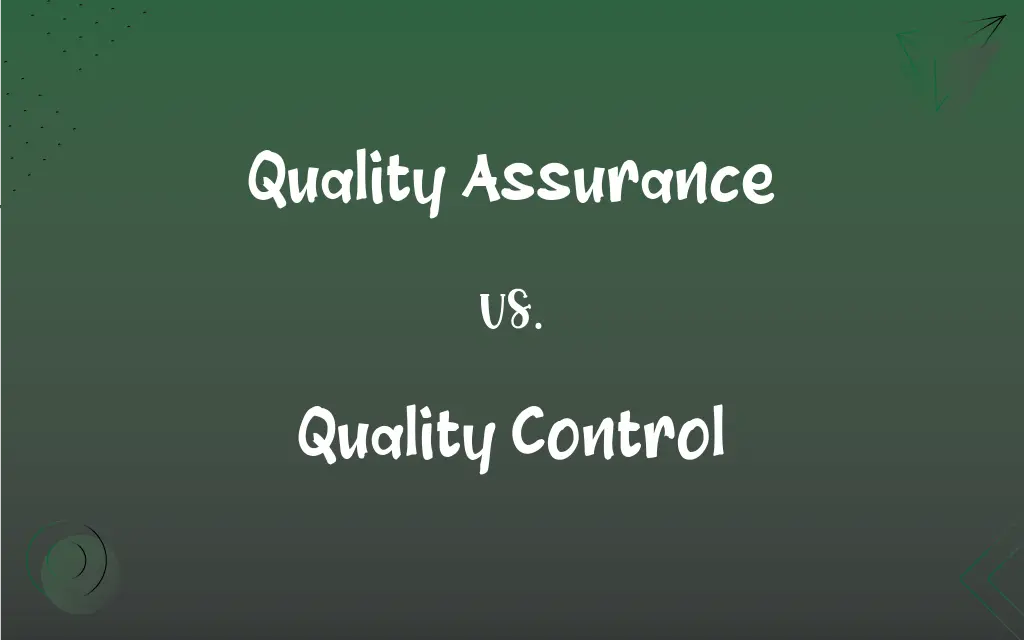Quality Assurance vs. Quality Control: What's the Difference?
Edited by Aimie Carlson || By Harlon Moss || Updated on October 24, 2023
Quality assurance focuses on process optimization to prevent defects, while quality control involves testing products to identify defects.

Key Differences
Quality assurance is a proactive approach that emphasizes the creation and implementation of systematic processes to ensure consistent quality outcomes. It aims to establish an environment where quality is inherent in the process, thereby reducing the likelihood of errors. In contrast, quality control is a reactive method, concentrating on identifying and rectifying defects in the final product. It primarily involves inspection, testing, and verification to ensure the product meets specific standards.
Quality assurance operates on the principle that a well-defined process will produce a high-quality product, minimizing the need for later corrections. This methodology prioritizes standardization, documentation, and continuous improvement. Conversely, quality control is more product-oriented. It checks products against predefined standards and specifications, rejecting those that don't meet the criteria.
In the broader context of a project or manufacturing setup, quality assurance ensures that procedures are designed to produce consistent quality. This could involve training, documentation, and regular reviews. On the flip side, quality control acts as a final gatekeeper, ensuring that only products meeting the desired standards reach the customer.
While both quality assurance and quality control aim to deliver a high-quality product, their methods differ significantly. Quality assurance focuses on building quality from the beginning, while quality control ensures the end product's quality by catching and rectifying defects.
Comparison Chart
Focus
Process.
Product.
ADVERTISEMENT
Approach
Proactive – aims to prevent defects.
Reactive – identifies and corrects defects.
Primary Method
Standardization, documentation, and continuous improvement.
Inspection, testing, and verification.
Outcome
Establishes an environment where quality is inherent.
Ensures the product meets specific standards.
Scope
Encompasses the entire process from start to finish.
Focuses on the end product and its conformity to standards.
Quality Assurance and Quality Control Definitions
Quality Assurance
A system to ensure consistent quality outcomes through standardized processes.
Through quality assurance, they achieved consistent product quality.
ADVERTISEMENT
Quality Control
A reactive approach that identifies and rectifies product defects.
Their stringent quality control rejected any substandard products.
Quality Assurance
Aims to establish an inherent quality environment.
Their robust quality assurance measures eliminated the need for extensive rework.
Quality Control
Ensures products meet specific standards through inspection and testing.
The quality control team inspected each item for defects.
Quality Assurance
A proactive approach focusing on preventing defects in processes.
The company's commitment to quality assurance minimized production errors.
Quality Control
Focuses on verifying the end product's conformity to set standards.
Through quality control, they ensured each batch met the desired specifications.
Quality Assurance
Prioritizes standardization, documentation, and continuous improvement.
Quality assurance practices led to constant process refinement.
Quality Control
Acts as the final gatekeeper for product quality.
Quality control ensured no defective units reached the market.
Quality Assurance
Encompasses the entire production process to ensure consistency.
From raw materials to finished goods, quality assurance played a pivotal role.
Quality Control
Primarily product-oriented, emphasizing the final outcome.
Their reputation for excellence was maintained through meticulous quality control.
FAQs
Which is more important, quality assurance or quality control?
Both are crucial. Quality assurance prevents errors, while quality control identifies and corrects any that happen.
What's the primary focus of quality assurance?
Quality assurance emphasizes process optimization to prevent defects.
Can a company have quality assurance without quality control?
While quality assurance aims to prevent defects, quality control is essential to catch any that do occur. Both are recommended.
Is quality assurance a one-time activity?
No, quality assurance involves continuous improvement and regular process reviews.
Is automation used in quality control?
Yes, many industries use automated systems for more accurate and efficient quality control checks.
Does quality assurance involve employee training?
Yes, training is often a component of quality assurance to ensure processes are correctly followed.
Can a well-defined quality assurance process eliminate the need for quality control?
Even with robust quality assurance, quality control acts as an added layer of verification.
Is quality control only applicable to manufacturing?
No, quality control can be applied to any industry where product or service standards need verification.
Can a product pass quality assurance but fail quality control?
Yes, while quality assurance aims to prevent errors, some defects might still occur, which quality control can catch.
How do companies measure the effectiveness of their quality assurance processes?
Through metrics like defect rates, customer feedback, and process audit results.
Is quality control just about product testing?
Quality control primarily involves testing, but it also includes inspection and verification against standards.
Are there specific tools for quality control?
Yes, there are various tools and methodologies for quality control, such as statistical process control.
Can customers influence quality assurance practices?
Absolutely, customer feedback can lead to process improvements in quality assurance.
How do companies decide on quality assurance standards?
Standards can be based on industry best practices, customer requirements, or regulatory guidelines.
Are there certifications for quality control?
Yes, various certifications, like ISO 9001, pertain to quality management and control.
Why is documentation crucial in quality assurance?
Documentation ensures processes are standardized and followed consistently.
How does quality control ensure product consistency?
Quality control checks products against predefined standards, ensuring consistency.
How does quality assurance benefit a company?
Quality assurance reduces production errors, leading to cost savings and enhanced customer satisfaction.
How often should quality control checks be conducted?
The frequency depends on the industry and product but can range from every batch to periodic sampling.
How are defects managed in quality control?
Defects identified through quality control are typically corrected or discarded, depending on the issue.
About Author
Written by
Harlon MossHarlon is a seasoned quality moderator and accomplished content writer for Difference Wiki. An alumnus of the prestigious University of California, he earned his degree in Computer Science. Leveraging his academic background, Harlon brings a meticulous and informed perspective to his work, ensuring content accuracy and excellence.
Edited by
Aimie CarlsonAimie Carlson, holding a master's degree in English literature, is a fervent English language enthusiast. She lends her writing talents to Difference Wiki, a prominent website that specializes in comparisons, offering readers insightful analyses that both captivate and inform.































































